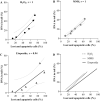Cell survival after DNA damage in the comet assay
- PMID: 34609522
- PMCID: PMC8536587
- DOI: 10.1007/s00204-021-03164-3
Cell survival after DNA damage in the comet assay
Abstract
The comet assay is widely used in basic research, genotoxicity testing, and human biomonitoring. However, interpretation of the comet assay data might benefit from a better understanding of the future fate of a cell with DNA damage. DNA damage is in principle repairable, or if extensive, can lead to cell death. Here, we have correlated the maximally induced DNA damage with three test substances in TK6 cells with the survival of the cells. For this, we selected hydrogen peroxide (H2O2) as an oxidizing agent, methyl methanesulfonate (MMS) as an alkylating agent and etoposide as a topoisomerase II inhibitor. We measured cell viability, cell proliferation, apoptosis, and micronucleus frequency on the following day, in the same cell culture, which had been analyzed in the comet assay. After treatment, a concentration dependent increase in DNA damage and in the percentage of non-vital and apoptotic cells was found for each substance. Values greater than 20-30% DNA in tail caused the death of more than 50% of the cells, with etoposide causing slightly more cell death than H2O2 or MMS. Despite that, cells seemed to repair of at least some DNA damage within few hours after substance removal. Overall, the reduction of DNA damage over time is due to both DNA repair and death of heavily damaged cells. We recommend that in experiments with induction of DNA damage of more than 20% DNA in tail, survival data for the cells are provided.
Keywords: Cell death and comet assay; DNA damage; DNA repair.
© 2021. The Author(s).
Conflict of interest statement
The authors declare that they have no conflict of interest.
Figures










References
-
- Anderson D, Dhawan A, Laubenthal J. The comet assay in human biomonitoring. In: Dhawan A, Bajpayee M, editors. Genotoxicity assessment: methods and protocols. Springer; 2019. pp. 259–274. - PubMed
MeSH terms
Substances
LinkOut - more resources
Full Text Sources

